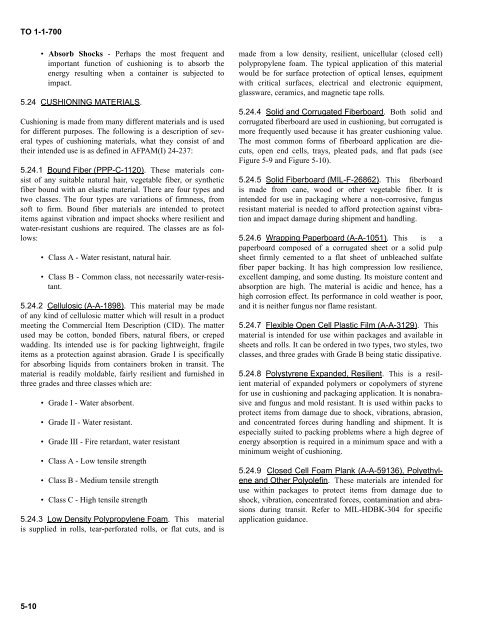TO 1-1-700 - Robins Air Force Base
TO 1-1-700 - Robins Air Force Base
TO 1-1-700 - Robins Air Force Base
You also want an ePaper? Increase the reach of your titles
YUMPU automatically turns print PDFs into web optimized ePapers that Google loves.
<strong>TO</strong> 1-1-<strong>700</strong><br />
• Absorb Shocks - Perhaps the most frequent and<br />
important function of cushioning is to absorb the<br />
energy resulting when a container is subjected to<br />
impact.<br />
5.24 CUSHIONING MATERIALS.<br />
Cushioning is made from many different materials and is used<br />
for different purposes. The following is a description of several<br />
types of cushioning materials, what they consist of and<br />
their intended use is as defined in AFPAM(I) 24-237:<br />
5.24.1 Bound Fiber (PPP-C-1120). These materials consist<br />
of any suitable natural hair, vegetable fiber, or synthetic<br />
fiber bound with an elastic material. There are four types and<br />
two classes. The four types are variations of firmness, from<br />
soft to firm. Bound fiber materials are intended to protect<br />
items against vibration and impact shocks where resilient and<br />
water-resistant cushions are required. The classes are as follows:<br />
• Class A - Water resistant, natural hair.<br />
• Class B - Common class, not necessarily water-resistant.<br />
5.24.2 Cellulosic (A-A-1898). This material may be made<br />
of any kind of cellulosic matter which will result in a product<br />
meeting the Commercial Item Description (CID). The matter<br />
used may be cotton, bonded fibers, natural fibers, or creped<br />
wadding. Its intended use is for packing lightweight, fragile<br />
items as a protection against abrasion. Grade I is specifically<br />
for absorbing liquids from containers broken in transit. The<br />
material is readily moldable, fairly resilient and furnished in<br />
three grades and three classes which are:<br />
• Grade I - Water absorbent.<br />
• Grade II - Water resistant.<br />
• Grade III - Fire retardant, water resistant<br />
• Class A - Low tensile strength<br />
• Class B - Medium tensile strength<br />
• Class C - High tensile strength<br />
5.24.3 Low Density Polypropylene Foam. This material<br />
is supplied in rolls, tear-perforated rolls, or flat cuts, and is<br />
made from a low density, resilient, unicellular (closed cell)<br />
polypropylene foam. The typical application of this material<br />
would be for surface protection of optical lenses, equipment<br />
with critical surfaces, electrical and electronic equipment,<br />
glassware, ceramics, and magnetic tape rolls.<br />
5.24.4 Solid and Corrugated Fiberboard. Both solid and<br />
corrugated fiberboard are used in cushioning, but corrugated is<br />
more frequently used because it has greater cushioning value.<br />
The most common forms of fiberboard application are diecuts,<br />
open end cells, trays, pleated pads, and flat pads (see<br />
Figure 5-9 and Figure 5-10).<br />
5.24.5 Solid Fiberboard (MIL-F-26862). This fiberboard<br />
is made from cane, wood or other vegetable fiber. It is<br />
intended for use in packaging where a non-corrosive, fungus<br />
resistant material is needed to afford protection against vibration<br />
and impact damage during shipment and handling.<br />
5.24.6 Wrapping Paperboard (A-A-1051). This is a<br />
paperboard composed of a corrugated sheet or a solid pulp<br />
sheet firmly cemented to a flat sheet of unbleached sulfate<br />
fiber paper backing. It has high compression low resilience,<br />
excellent damping, and some dusting. Its moisture content and<br />
absorption are high. The material is acidic and hence, has a<br />
high corrosion effect. Its performance in cold weather is poor,<br />
and it is neither fungus nor flame resistant.<br />
5.24.7 Flexible Open Cell Plastic Film (A-A-3129). This<br />
material is intended for use within packages and available in<br />
sheets and rolls. It can be ordered in two types, two styles, two<br />
classes, and three grades with Grade B being static dissipative.<br />
5.24.8 Polystyrene Expanded, Resilient. This is a resilient<br />
material of expanded polymers or copolymers of styrene<br />
for use in cushioning and packaging application. It is nonabrasive<br />
and fungus and mold resistant. It is used within packs to<br />
protect items from damage due to shock, vibrations, abrasion,<br />
and concentrated forces during handling and shipment. It is<br />
especially suited to packing problems where a high degree of<br />
energy absorption is required in a minimum space and with a<br />
minimum weight of cushioning.<br />
5.24.9 Closed Cell Foam Plank (A-A-59136), Polyethylene<br />
and Other Polyolefin. These materials are intended for<br />
use within packages to protect items from damage due to<br />
shock, vibration, concentrated forces, contamination and abrasions<br />
during transit. Refer to MIL-HDBK-304 for specific<br />
application guidance.<br />
5-10
















